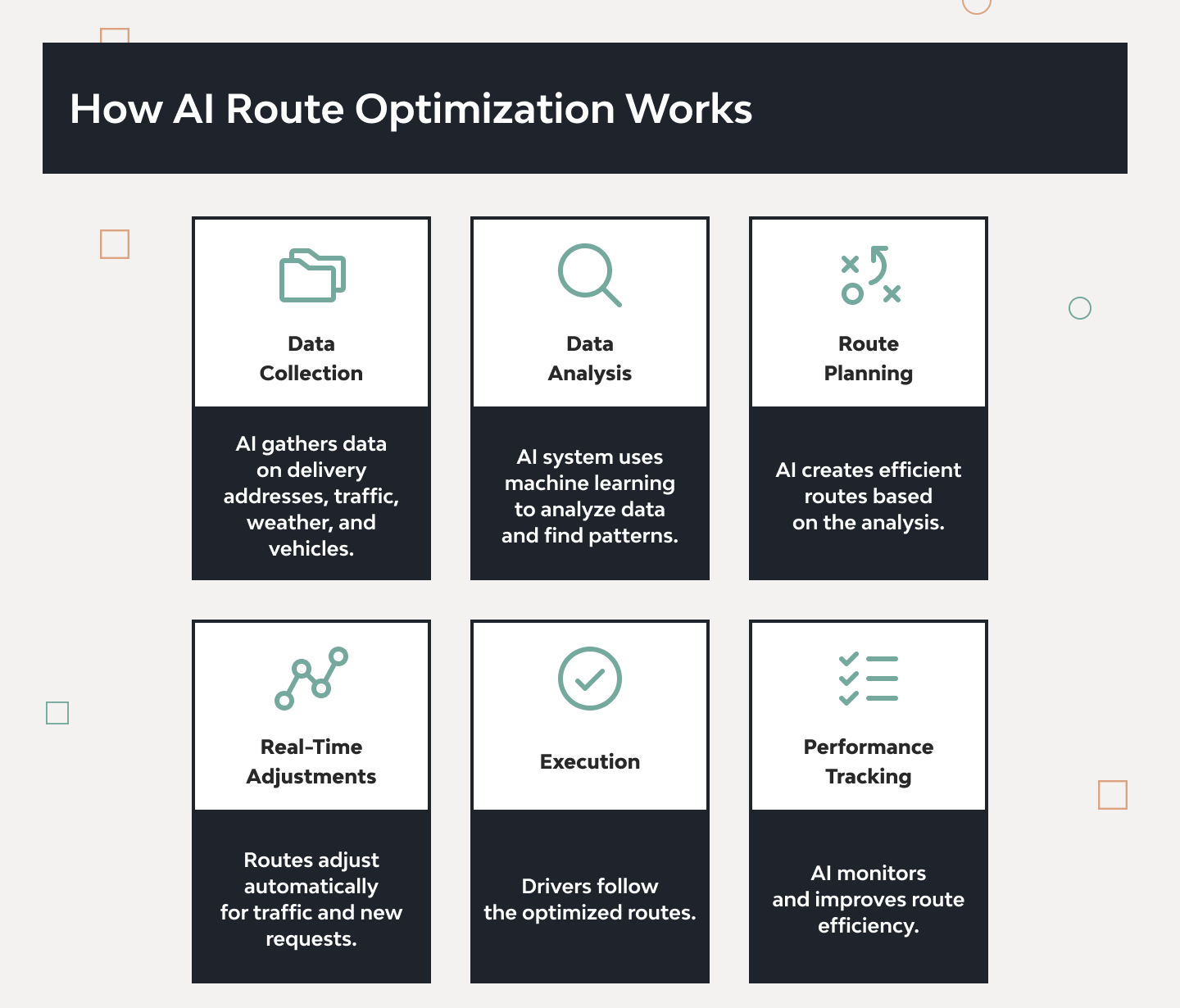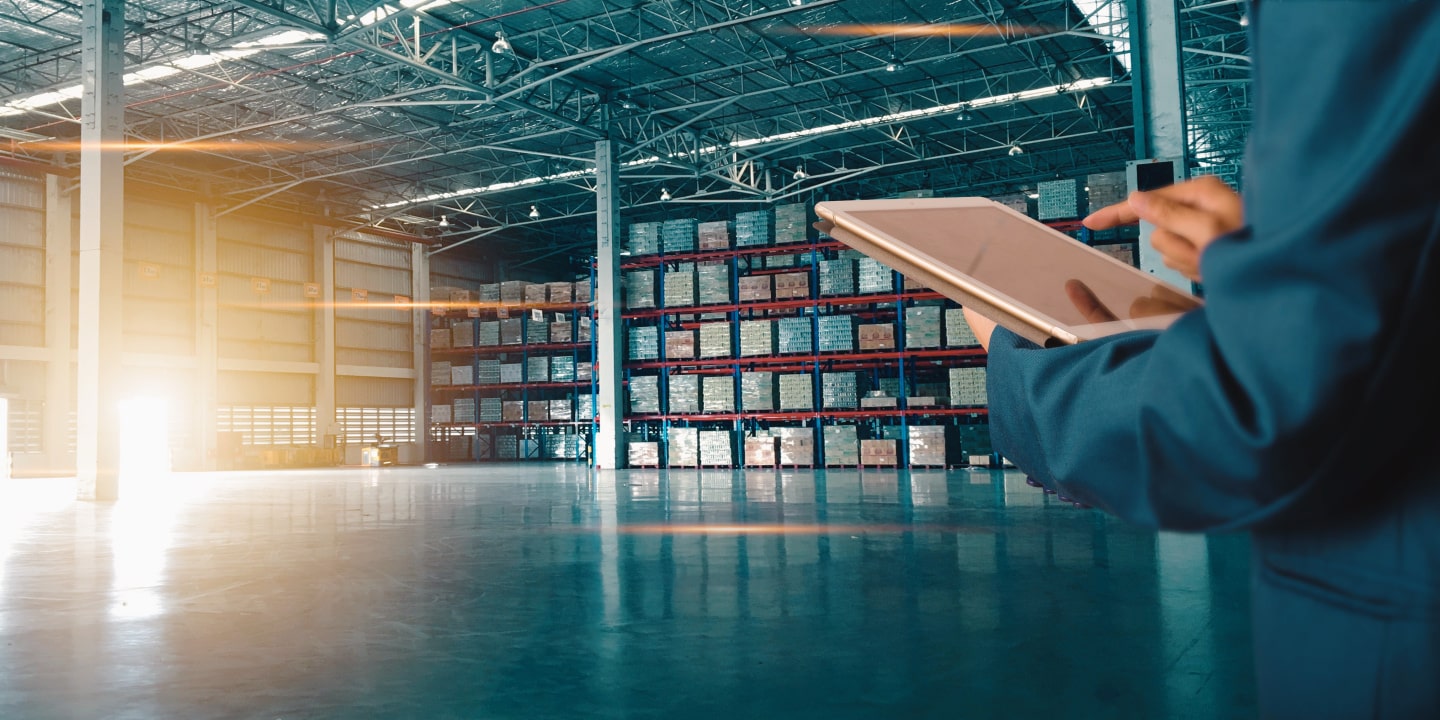AI in Fleet Management: Benefits and Top Use Cases

Logistics and transportation are changing rapidly, as door-to-door deliveries have become a daily norm. However, to achieve faster and more reliable operations, today’s fleet operators must deal with growing fuel costs, tighter regulations, heightened driver safety expectations, and increasing customer demand, all simultaneously.
To streamline processes, automate tasks, and centralize operations, companies often leverage AI in fleet management. Intelligent tools enable more than just fleet tracking — they strengthen your connection with trucks, predict cost-inefficient issues, and enhance logistics efficiency.
From route planning and maintenance to automating safety alerts and risk detection, AI helps cut costs and scale operations in new and innovative ways. But how is AI specifically used in fleet management?
The technology behind AI fleet management
To figure out the main AI applications in fleet management, we should first take a look under the hood, at the core technologies that power smarter fleets:
Telematics
Truck sensors can collect GPS location, speed, fuel usage, engine diagnostics, and more data that can be used as input for AI systems. An innovative model can thus monitor performance, detect anomalies, and optimize operations insightfully.
IoT sensors
Integration with telematics and IoT systems can provide streams of data from various vehicle components, including tire pressure, engine temperature, brake wear, cargo conditions (such as temperature and humidity), and the driver’s environment (via fatigue sensors or dash cams).
Machine learning
ML algorithms use historical and current data to detect patterns (for example, when certain parts tend to fail), predict when maintenance will be needed before breakdowns, flag driver behavior, and forecast traffic. Along with a core model, they help set AI fleet management in motion.
Real-time analytics
How is AI used in fleet management for more in-depth data analysis? Real-time data analytics can detect changes in traffic, weather conditions, and mechanical warnings. Operators (or AI systems themselves) can take immediate action, such as alerting drivers, rerouting vehicles, or rescheduling to avoid delays or potential dangers.
How is AI used in fleet management?
What are the top use cases for AI in IT fleet management? Here’s what we can highlight based on our own experience in fleet management software development, combined with notable real-world cases.
AI-powered route optimization
Optimizing routes based on traffic, weather, delivery windows, and vehicle status reduces travel time, saves fuel, and ensures reliable logistics. AI-powered route optimization helps redirect shipments in real-time, as soon as sudden delays occur or better paths become available. As a result, fleets can move faster at a lower cost while keeping customers satisfied.
Use case: In Indonesia, a large coal mine used the MineCare platform with custom dispatch and performance management tools to monitor haul trucks, reducing overall fuel consumption by 18%.
Predictive maintenance planning
Instead of waiting for breakdowns to occur and react, AI utilizes historical data and sensor readings to forecast component wear, anticipate potential component failures, and schedule maintenance. Predictive maintenance planning helps avoid the downtime caused by repairs, minimize unplanned costs, and boost vehicle life.
Use case: Penske Truck Leasing in the US implemented a proprietary AI that detects early signs of maintenance issues for over 200,000 trucks.
Fuel and cost analytics
AI aggregates data on fuel usage, idle time, driving behavior, route efficiency, and vehicle condition. All this can be utilized for budget-saving fuel and cost analytics — the insights can help you adjust the behavior of your fleets (e.g., reducing idling or improving driving efficiency), routes, or hardware to conserve fuel costs and lower operating expenses.
Use case:Among the industry-wide AI applications in fleet management, a European food-wholesale company Metro Cash and Carry deployed a route optimization platform to reduce delivery costs by 13%.
Driver behavior monitoring
Using sensors and even video or telematics data, AI can track how drivers’ behavior in real-time, including their speed, braking, and acceleration patterns, lane changes, and distraction factors. Based on that, you can provide helpful feedback, tips, and traffic alerts.
Use case: HCSS Telematics has been providing AI solutions designed specifically for responsive driver behavior monitoring in construction fleets.
Real-time vehicle tracking
By integrating GPS with IoT and smart telematics, you can launch live data feeds from trucks, managed via an easy-to-use, centralized dashboard. Fleet managers can use it to monitor shipment locations, ETAs, delays, and the condition of their vehicles.
Use case: MasTrack leverages GPS real-time vehicle tracking to dynamically switch routes, respond to breakdowns or emergencies, and maintain customer communication.
Automated compliance reporting
Depending on where you operate and at what scale, logistics can be highly regulated. It requires you to log activities, conduct regular inspections, and disclose emissions data, driver hours, and safety reports. AI automates much of this routine.
Use case: With automated compliance reporting, FleetRabbit autonomously collects required data, generates reports, and provides personalized reminders.
Smart load and capacity planning
AI helps match cargo loads with vehicle capacity, plan efficient load distributions, and avoid under-utilization or overloading. It can optimize what gets loaded, when, and on which vehicle to maximize revenue and minimize waste.
Use case: UnoiaTech deployed a real-time fleet optimization AI agent that considered delivery priority and vehicle load for better drop-off sequences.
Demand forecasting for fleet usage
Using historical delivery volumes, seasonal patterns, economic indicators, and other data, AI predicts demand spikes or drops. With that info in hand, fleets can scale services accordingly and contract new suppliers cost-efficiently.
Use case: Warke Technologies implemented short-term demand forecasting for fleet usage, resulting in significant improvements in flexibility for staffing, vehicle allocation, and scheduling.
Safety alerts and risk detection
AI systems can detect risks that the human eye cannot see, such as impending mechanical failures (e.g., brake or tire issues), unsafe weather or road conditions, cargo malfunctions, or unusual patterns in drivers’ behavior on the road.
Use case: FleetSafe.ai helps avert thousands of accidents through early alerts, predictions, and preventive measures.
Benefits of AI in fleet management
Implementing AI in fleet management equips a fleet owner with responsive tools and performance-boosting automation. A smarter, more flexible fleet brings the following benefits:
Lower costs
Smart load and capacity planning lead to faster service, lower fuel consumption, and more balanced fleet expenses overall. AI helps synchronize fleets and centralize their management, tasking, and tracking. It also helps minimize average idle times, unplanned service calls, and overstacking of goods.
On top of that, all the data you get from AI/ML analytics engines can be used to optimize inefficiencies, fill up unused capacities, and scale operations under the hood without holes in the budget.
Improved safety
Drivers are safer on the road thanks to responsive, real-time monitoring and end-to-end service connection. They can be alerted about both short-term dangers and long-term risks. It’s easier to stay on time due to proactive forecasting and adjustable scheduling.
And, of course, using connected IoT sensors, an AI system will collect a wealth of data on the truck’s performance and maintenance status. It can help further reduce the likelihood of accidents by inspecting statistics, trends, and vehicle readings.
Better service
One significant benefit of AI applications in fleet management is that they can eliminate human factor errors and inaccuracies. This results in more accurate ETAs, more reliable deliveries, faster response to delays, and better communication with customers.
With real-time vehicle tracking, intelligent scheduling, and forecasting, a fleet can be fully automated without fear of missed deadlines or incomplete reports.
Sustainability
AI fleet management is also more environmentally friendly, making for greener delivery services. It is essential in professional interstate, long-distance, or global logistics, where you must meet regulatory standards and maintain certifications and licenses.
Fewer, faster, and more balanced routes result in fewer harmful emissions and foster a positive social image of one’s brand. Logistics brands are the foremost consumers of fossil fuels, after all.
Challenges and risks of AI in fleet management
As you can see from the cases above, the real-world application potential of AI in fleet management services has been demonstrated on numerous occasions. However, several common challenges and risks remain associated with its adoption. Understanding these will give you an upper hand and prepare you for efficient AI integration with the fleet.
Poor data quality
However advanced an AI model is, it’s nothing without well-sourced, readable data. If truck sensor readings are inaccurate, telematics data is noisy or incomplete, or there are missing maintenance logs or faulty devices, the AI model may make wrong or misleading predictions.
It is why it’s crucial to sift through and dispose of any unreliable data if it does seep into the system.
Legacy integration issues
Hundreds of fleets run on older systems and non-AI infrastructural approaches. Depending on the specific legacy hardware, ERP system, maintenance software, or vehicle platforms, AI can be either impossible or very costly and complex to integrate. It will likely require extensive and expensive custom work. So you need to be well-prepared for such a case.
High upfront costs
Integrating AI with a fleet of trucks or other vehicles requires a significant upfront investment in software, hardware components, and expertise. You will need to purchase sensors or telematics hardware for connectivity, set up an ML analytics platform, and train staff to use new tools and automation.
For a small- or mid-sized fleet expecting faster ROI, outsourcing or cost model optimization is recommended.
Shortage of technical expertise
How is AI used in fleet management at different scales? It depends on the range of expertise a company is ready to invest in. Building, managing, and maintaining AI systems requires data scientists, ML engineers, or specialized vendors.
Also, uncertainty over privacy and regulatory compliance (especially around driver data) can demand more security specialists and admins.
How to implement AI in fleet management
To give you a more detailed understanding of AI applications in fleet management, here’s a summarized roadmap for developing a new smart system for logistics. These are the stages that you usually go through:
Define goals and metrics
Start with the prioritized issues or performance gaps that you would like to address and list plausible solutions — e.g., saving more fuel, boosting safety monitoring, or reducing harmful emissions. Include the specific metrics you expected to improve with AI, like uptime, accident rate, fuel per mile, customer satisfaction rates, etc.
Audit existing systems and data
Assess the hardware and software you have, including telematics devices, sensor coverage, connectivity, and data storage. Check the quality of the data you generate, the consistency of your digital infrastructure, and any existing flaws.
Choose technologies and partners
You will need to pick the required sensors, telematics, ML platforms, and analytics tools. If you don’t have in-house capability, a trusted vendor should help you set up a compatible, AI-enabled tech stack for optimal integration.
Pilot small, scale gradually
For long-term efficiency, run a pilot AI project targeting a specific aspect, such as route optimization, in a smaller portion of the fleet. Measure the pilot integration’s performance, customize it as needed, and then scale it to full deployment.
Train staff and build processes
Once an in-house team or a hired vendor integrates AI or implements a new custom system for you, your existing drivers, fleet managers, and maintenance crews will need to be onboarded on all workflow changes.
Ensure regulatory and privacy compliance
Implementing AI in fleet management services may impact how data is processed, and therefore your entire regulatory compliance. Be aware of laws governing driver data, GPS tracking, safety, and emissions.
Monitor, refine, and scale
After deployment, you’ll be able to use real-time analytics to constantly track the new AI system’s performance versus the expected metrics. This is the time to collect feedback on improvements and refine the AI.
Future trends in AI fleet management
Now, we’ve done a good job clarifying the question: how is AI used in fleet management today? But what shifts and tendencies should we expect in the near future?
- Edge computing integrations
Instead of always sending data to the cloud, more vehicles will process data directly on board, using in-vehicle devices or nearby data beacons.
- 5G integrations
Faster, more reliable 5G data links will enable vehicles to share data instantly on the go.
- Electrification
More electric vehicles are expected to be adopted, which will soon make battery health and charging schedules among the primary metrics for fleet management.
- Focus on sustainability
Environmental concerns will prompt fleets to reduce emissions and balance fuel and energy consumption, both through AI fleet management and other innovations.
AI in fleet management: The new norm
The AI in fleet management is transforming logistics, from more intelligent routing and predictive maintenance to fuel analytics, safety alerts, compliance automation, and demand forecasting. The use cases we mentioned only reinforce the power of AI as a significant new paradigm shifter for deliveries.
Now’s the perfect time to integrate any AI-based solutions, refine them, and drive your competitive edge in the market. Django Stars will assist you with that through deep technical expertise and hands-on experience in designing and building AI in fleet management services.
How can you leverage AI fleet management for the benefit of your business? Contact us to discuss your first steps, get receive a project estimate, and discover the long-term benefits.











